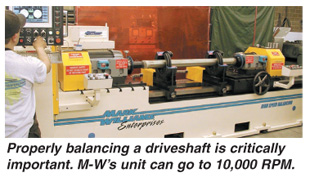Toll Free: 1-866-508-6394
OR Contact Us
OR Contact Us
Shop by Category
There are many parameters to consider when it comes to selecting a driveshaft for your race car. These include the length of the shaft, the critical speed it will attain, the tube material type and size, the U-joint type, class requirements and budget.  Most important is the Critical Speed. Essentially, any rotating shaft will reach a point where it will become dynamically unstable. This leads to a “whipping” or “jump-rope” effect that causes violent vibration and ultimately leads to driveshaft failure. Critical Speed is a function of the shaft’s length, material stiffness and tubing diameter. Shorter shafts, made of stronger material, and having a larger diameter account for the highest Critical Speed potential. For example, 52" long driveshaft made of 3" diameter mild steel will have a Critical Speed rating of 6,322 RPM. Make it from 3-1/2" o.d. tubing and it’ll go to 7,322 RPM, and with big 4" o.d. tubing 8,246 RPM is possible. Similar variations are reflected in various diameter 4130 steel, 6061 aluminum and MMC (Composite Aluminum Tubing) aluminum shafts. The absolute highest critical speed ratings are for carbon fiber shafts, typically found only in cars that buzz through the lights in excess of 10,000 RPM. All of this information can be found online at www.markwilliams.com. Most driveshafts used in drag racing employ 1350-series U-joints, although for high horsepower, Pro-Mod applications 1480-series joints are starting to be introduced for specific transmission/rear axle combinations. There are also differences in U-joint construction, ranging from stock Spicer units with zerks to solid non-internal greasing units. OEM-style U-bolts are also suspect in severe duty applications, and M-W offers a billet steel cap assembly that can handle up to 500 foot lbs. additional torque. How has all of this been quantified? Mark Williams Enterprises has developed an immense Torsional Testing Device that can exert up to 20,000 lbs. of torque and is used for a variety of purposes, including verifying the bonding strength of all M-W “Accu-Bond” driveshafts and conducting tests for SFI to determine compliance with SFI 43.1 Specs. Proper phasing of the U-joints to the shaft is critical, and for drag racing applications a “0” phase setup (front and rear U-joints are in the exact same position) has proven to be the best. Balance is also important, and can have an effect on performance because the laws of physics tells us additional radial power is required to turn an eccentric shaft, You’ll get more power to the ground if the driveshaft is perfectly balanced.  To assure this, M-W has a sophisticated computer-controlled balancer that can spin test to 10,000 RPM and is used to replicate actual operating conditions. The shafts are balanced to G30 specifications. There are also factors, such as transmission and rear end yokes, to consider. But in the end it’s best to put your trust in a reputable manufacturer rather than rely on warmed-over stock components. Gotta watch getting “shafted.” |
 |